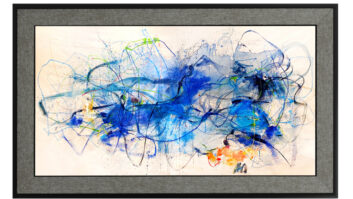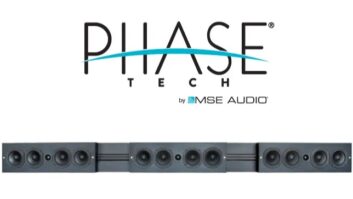Although it’s still about the music, the types of music sources, the way music is routed throughout the house, and the control capabilities of distributed-audio systems keep on changing. Here’s a brand-by-brand guide to some of the changes:
AudioAccess: A two-way RS-232 interface module enables wall-mountable CATC color touch screens to display program metadata from RS-232-equipped music servers and from CD/DVD-management systems supplied by other companies. For now, the interface supports ReQuest Audio and Escient servers and management systems.
The touch screen and servers connect to the module, which in turn connects to the AudioAccess PX-700 distributed-audio controller. The suggested retail is $260. One interface is needed for each connected device.
Also because of the interface, an AudioAccess system for the first time gains two-way RS-232 control of home systems such as lighting. Company systems having previously enabled only one-way RS-232 control. For now, the system features two-way drivers only for Lutron HomeWorks Lighting systems.
Crestron: The company’s first two receiver-based systems are the 12-channel ADAD (Adagio audio distribution system) and 12-channel Adagio ADES (Adagio Entertainment System), which can be linked to the company’s first HDD music server. Both six-zone devices incorporate 12×45-watt amplification.
The ADAD includes built-in AM/FM tuner and built-in XM satellite tuner. The ADES version lacks built-in tuners but features three tuner card slots. Each slot accepts a dual AM/FM tuner, AM/FM/XM tuner, or AM/FM/Sirius tuner. ADES also offers more looping stereo inputs and more IR and RS-232 ports.
Both receivers connect to an Adagio ADAE audio expander to add another six audio zones via its 12×45-watt amplifier and to Crestron’s CEN-iPOD docking station, which delivers full control over an iPod, including song selection by title, from Crestron’s keypads and touch panels.
Neither receiver requires programming to set up, and they are plug-and-play compatible with the audio server. They are available in packages with Crestron’s TPS-4-l 3.5-inch wall-mount touch panel and the AD-LCD keypad
Both receivers can be integrated with Crestron’s whole-house automation systems, including the Crestron 2-Series home-control system and wireless infinNET-technology dimmer switches.
To the ADAD functions, ADES also adds 10 looping stereo inputs vs. four, preamp outputs that can be fixed or variable, eight IR ports instead of four and two RS-232 ports instead of one.
The $2,400-suggested ADAD and $3,600 ADES ship in September along with the server, priced from $3,200 to $6,900 depending on capacity.
iMuse: Music/video/photo servers are the first distributed-audio products from the Colorado Springs company, which last year showed a music server that it didn’t ship in order to develop a A/V server. (See p. 33.)
M&S Systems: The Dallas-based intercom maker, owned by Linear, will unveil its first distributed-audio system to incorporate intercom capability. The four-zone, six-source Xtreme Digital Music system uses two-gang amplified in-wall keypads that also serve as an intercom to talk to a person at the front door or in other rooms. Replies can be heard through the room’s in-wall or in-ceiling speakers. The speakers also mute when the doorbell rings.
Digital audio and control signals are carried by a single CAT-5 cable between a router box in the central A/V stack to each keypad. Power is sent from the router box via separate cable to the keypads, which incorporate 2×30-watt (into 8 ohms) Class D amplifier and a local-source input.
The system is expandable to eight zones.
In related introductions, M&S will show a retrofit intercom system that replaces most three- and four-wire intercom systems without running new wire or breaking drywall. The DMC3-4 wall stations accept an add-in stereo amplifier to amplify remote music sources. Details were unavailable.
A CAT-5-based DMC-1 intercom system also features wall stations with optional stereo amplifiers.
MTX Audio: The brand will diversify from architectural speakers to distributed-audio infrastructure with the launch of a system based on A-BUS technology developed by Australia-based LeisureTech. Another Mitek company brand, Atlas Sound, already offers a distributed-audio system called Varizone.
A-BUS delivers preamp-level audio, control signals and power via a single CAT-5 cable to amplified in-wall volume controls and keypads to simplify system architecture and reduce costs.
MTX’s A-BUS products include amplified in-wall volume controls with IR receiver; programmable IR remotes; a local-source in–wall input; and three central distribution hubs: one-source/two-zone, one-source/four-zone, and four-source/four-zone. Multiple hubs can be linked to expand the system to more zones.
Suggested retails of select SKUs are $249 to $799 for hubs and $209 to $249 for amplified volume controls with IR remotes.
Jamo: The company is expanding its selection of A-BUS-standard distributed-audio products, having launched its first A-BUS infrastructure late last year. The latest entry is the $189-suggested LKP4.6 source-control keypad with LCD display, IR learning and alarm clock. The LM4.6 wall plate enables the keypad to control a local source.
NetStreams: The company’s first home-control interface, the ControLinx CL100, delivers two-way control of Lutron lighting systems and Aprilaire HVAC systems through the company’s IP-based DigiLinX distributed-audio system.
It also provides one-way control of RS-232-based systems as long as the dealer knows the RS-232 codes and programs them in. And it also connects to home systems controlled by IR, allowing for first-time control of IR-based non-audio home systems. It’s available now.
Drivers are planned for two-way control of other brands of home systems.
One CL 100 is needed per home system, and each can be controlled from the distributed-audio system’s keypads, wireless Web tablets, wireless PDAs or PCs. It also interfaces the distributed-audio system with doorbells and telephone-muting systems.
NuVo Technologies: The company will display an upgraded entry-level distributed-audio system and its first satellite-radio tuners, one with dual XM tuners and one with XM/AM/FM tuner. All are due by late August or early September.
The entry-level system, the Simplese D, is a single-box controller/amplifier packaged with keypads for four rooms. The four-zone system has been upgraded to offer four sources from two, and it has been slimmed down. It delivers 30 watts per zone at a suggested $999, the same price as its predecessor.
The company will talk up, but not display, a new brand, BreatheAudio, targeted exclusively to big-box retailers. The brand includes the Elevate distributed-audio system and Resonate custom speakers. Elevate is a two-source, four-zone system with in-wall keypads. All point-of-sale material, manuals and packaging will lack references to NuVo.
Oxmoor: The Klipsch-distributed brand will add new in-wall amplifier/controllers to its ZON distributed-audio system. The current ZAC-60 fits in a double-gang box, but the new ZAC-30 and ZAC-30jr fit in a single-gang box for use in such locations as master bathrooms and sunrooms. Both feature an onboard 30-watt digital amplifier instead of a 60-watt amp.
The ZAC-30 features an LCD display, while the ZAC-30jr lacks a display. Each in-wall controller connects via a single CAT-5e or CAT-6 cable to a central router that digitizes all audio sources and sends the digital signals and low-voltage power to the in-wall controllers. Oxmoor is able to deliver sufficient current via CAT-5 to power the amplifiers because current is passed through every CAT-5 conductor.
Power and digital signals share the same conductors in a manner roughly analogous to the way that a home’s power lines distribute power and signal when connected to products that use the HomePlug power-line network standard.
In other news, the company will show an MP3 doorbell module, which connects to the ZON-system router to reproduce user-created audio through a ZON system’s speakers when triggered by doorbells, driveway sensors and the like. The module plays up to five separate MP3 files stored in the module’s removable SD memory card or Oxmoor-provided default doorbell embedded in the module. The duration of the MP3 sounds can be as long as allowed by the SD card’s capacity.
Pioneer: The company’s first three-zone receivers are the Elite series $1,700-suggested VSX-74TXVi and $1,400 VSX-72TXi. Up to three separate sources can play simultaneously. Their built-in seven-channel amplifiers drive two zones, while the third zone is driven, via a digital output, by an outboard amplifier with digital input.
They are the company’s first two XM-ready receivers and first iPod-controlling models, which display iPod menus on their front-panel displays and on a connected TV and allow full iPod control through the receiver’s remote. In single-zone and multizone modes, they stream one XM channel and one iPod song at a time.
When the receivers are connected to two-way RS-232-based distributed-audio systems, menus would appear on remote touch screens only if the touch screens have a live video window that could display the receivers’ open source definition. Otherwise, RS-232 and IR-based touch screens and keypads would control basic iPod functions, such as on/off and track up/down. Codes for those functions will be posted on Pioneer’s Web site.
Both THX Select 2 receivers feature RS-232 ports and up-converting HDMI output, but they do not up-scale to high definition. The 74TXi adds a USB port for PC connectivity and two IEEE 1394 inputs for DVD-Audio and SACD connections.
Proficient: The four-year-old brand will diversify from architectural and box speakers into distributed-audio electronics that will include a multizone/multisource stereo receiver, high-current amplifiers, in-wall volume controls, speaker selectors and IR repeater equipment.
The M6 receiver, dubbed a dual-tuner controller by Proficient, incorporates a 12×30-watt amp, dual AM/FM tuners and six-zone eight-source capability. It’s packaged with six in-wall keypads with an integrated IR receiver at a dealer cost of $1,500.
Another controller, which lacks tuners, is the six-source, four-zone M4 at a $900 dealer cost with four keypads and 8×30-watt amplification. It also expands.
The M5 is a 2×65-watt amp with speaker selector.
Russound: Two new audio-distribution systems and the company’s first dedicated intercom system will be displayed.
The ComPoint intercom system, due in December, lacks embedded speakers in their keypads but integrates with a distributed-audio system’s in-wall and in-ceiling speakers to reproduce doorbell chimes and voices originating from other rooms and from exterior entrances. The keypads’ built-in amplifier drives the speakers. Pricing was unavailable.
In replacing its CA series of two distributed-audio systems, Russound will show two new system controllers, four new keypads and three IR remotes. The system controllers are the $1,599 street priced six-source, six-zone CAA66 and the $999 four-source, four-zone CAS44. Compared to their predecessors, they add RS-232 port, more inputs, keypad control of bass and treble and the ability to support up to three keypads per room or zone, allowing for system control from multiple spots in large rooms.
To eliminate keypad programming, the CAA66 comes with an internal IR database, while the CAS44 comes with an IR library in an IR remote.
The CAA66 offers two more sources than its predecessor at the same price, and the CAS44 offers the same number of sources as its predecessor.
A CAA66 system with six keypads ranges in price from $2,199 to $2,599, depending on keypad. A CAS44 packaged with four keypads ranges from $1,599 to $1,999.
Sunfire: In upping its custom commitment, the company will show its first distributed-audio amplifiers, which drive eight and 16 channels, respectively; its first in-wall subwoofer; and its first on-wall/on-stand speakers, which are also the company’s first non-sub speakers.
The amps are rated at 16x200watts and 8×100 watts. The suggested retails are $3,995 and $1,495, respectively.
Xantech: To reduce system costs and simplify installation, the BXAUDIO4X4 system incorporates controller and amplifier into a single chassis and is packaged with four keypads, four remotes and IR emitters at a suggested $1,400. The system, already available, is a four-source, four-zone system expandable to eight zones.
Yamaha: A wealth of new products includes two new three-zone receivers, raising the three-zone selection to three. The latest models, the $1,099-suggested RX-V1600 and $1,399 RX-V2600, are six-source models that drive three zones simultaneously via their internal seven-channel amps. A fourth zone can be driven through the speaker B output.
The receivers, due in October, also signify an expanded selection of XM-ready receivers. (See p. 26 for details.)













